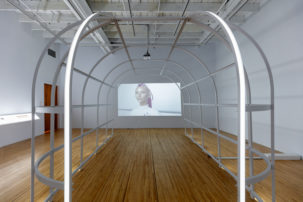You know that other person who seems to live inside your computer, tablet or smartphone? The one who looks just like you, but is only a kind of faded, shadowy mirror image glimpsed as you ingest websites, emails, social media updates and the like?
Well, that person also happens to be in evidence at “Screen and Décor,” a group show at the Justina M. Barnicke Gallery in Toronto. Curated by Canadian Art contributor Rosemary Heather, “Screen and Décor” aims to demonstrate the effect that digital media is having on artmaking—but it does so in a rather unexpected way. As Heather puts it in her curatorial essay, “The question of why there are no significant digital artworks is a red herring. It is a problem of looking in the wrong direction—of looking to the computer for evidence of the type of art this media makes possible. Rather, the effect digital media is having on artmaking is found off the screen.”
Accordingly, there are no digital artworks and no computer monitors in “Screen and Décor.” However, there is an unexpectedly effective installation by Rodney LaTourelle and Louise Witthöft that evokes the mirror-like-yet-window-like quality of a computer screen. In panes of coloured Plexiglas that hang throughout the gallery, that common digital experience of looking at something else while catching a glimpse of oneself is highlighted. So is the sense of reading content through multiple panes that are ever-shifting in relation to one’s own position or timeline.
Through and around LaTourelle and Witthöft’s installation, one can view collages, assemblages, curtains, sculptures, paintings and prints by Shannon Bool, Simone Gilges, Bernhard Kahrmann, Sanaz Mazinani, Emmy Skensved and Kirstine Roepstorff. In some cases, it seems clear how these works might relate to the effects of digital media; in other cases, less so.
Kahrmann’s laser print Le Pli might be read simultaneously as a metaphor for hyperlinked media and as a 21st-century update of M.C. Escher’s Drawing Hands. In it, one hand folds the edge of a photocopied print in which a hand is folding back the page of a book. Other prints still lie behind it, suggesting “pages” hiding behind the primary one on view.
The works of Bool, Gilges and Skensved all also address, in their own ways, ideas or motifs of layering. Bool’s silk paintings accumulate patterns and figures, while Gilges literally folds silk pieces on top of analog photographs and Skensved manipulates overlapping forms to create glossy monochromatic voids in her paintings—voids that also, in context, evoke the nature of the digital screen as being at once empty and full.
Mazinani’s kaleidoscopic arrangements of politicians’ faces play more on the kind of mirroring and media-spiralling afforded by digital means. Roepstorff’s collage and curtain seem to integrate elements from all of the above; in her large textile and paper works, small fabric swatches read as corrupted pixels and as material depths.
“Screen and Décor” doesn’t pretend to be conclusive about the effects of digital media. But like a good blog post, hyperlink or animated GIF, it opens up an illuminating perspective on how we live now, while continuing to point back to what has come before.
The show also prompts reflection on the nature of the screen (increasingly our portal to the world, if my observation of public-transit reading habits can be trusted) as something that is both solid and permeable, substantial and insubstantial, concealing and revealing.









